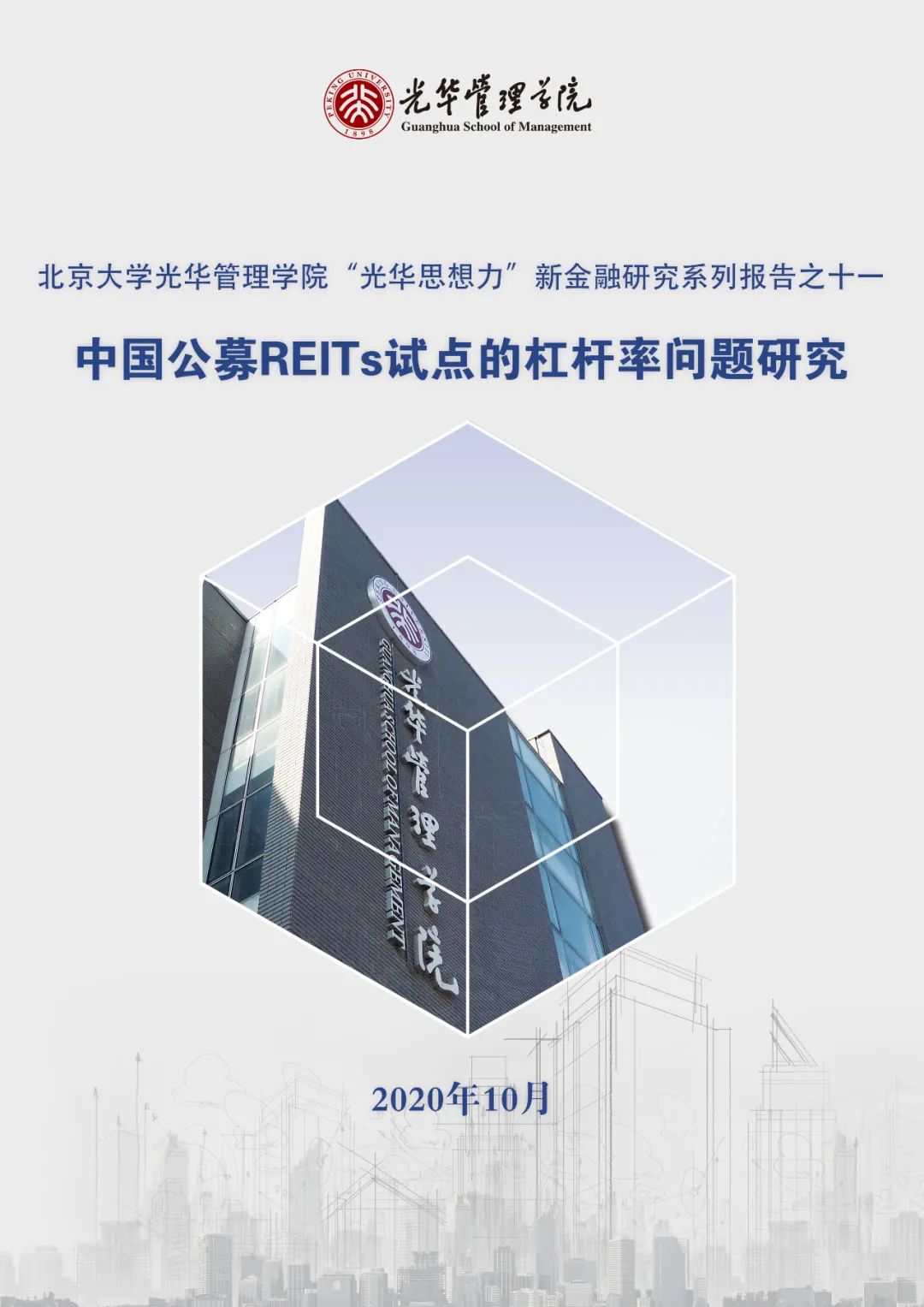SECTIONS Guanghua Insights
In a financial market,leverage is a double-edged sword.
A draft guideline on China’s infrastructure real estate investment trusts(REITs)has prompted discussions far and wide, and one of the hotspot topics centers around the REIT leverage ratio.
What are the current leverage ratios in other countries? What are the factors that determine this ratio in terms of mechanism design? How to make sense of China’s current leverage ratio? A report from Peking University’s Guanghua School of Management, the 11th in its“Thought Leadership” new finance research series, offers insights into these questions.

CROSS-COUNTRY DATA
Observing the public real estate markets around the world, Guanghua’s REITs research team integrates capital structure theory into its analysis of the REITs field.
According to the FTSE EPRA/Nareit index,42 countries have adopted REIT regimes as of this Jan., with a combined market value of nearly two trillion U.S. dollars. Rules with respect to maximum leverage ratios vary, but most fall into four categories: The first includes the U.S., Canada,Japan,Australia,France,Spain, and Brazil, which place no legislative or statutory limits on leverage but may tighten the tax shield policy for a firm if its leverage is believed to have exceeded acceptable levels;Represented by China’s Hong Kong, Singapore, Germany, and the Netherlands, the second group sets a maximum permitted leverage or the ratio of the outstanding debt of REIT-like entities to total asset value;The U.K. and Ireland do not set a ceiling but stipulates an interest cover test in which the property profits must be at least 1.25 times the property financing costs;A minority of countries like Italy and Chile require interior regulations approved by shareholders to set the leverage ratio limit.
China uses the indices adopted by most countries to calculate leverage ratio — the ratio of total debts to total assets. With the world’s largest REIT market,American REITs have maintained an average leverage ratio of 50 to 60 percent over the past two decades,notably higher than the ratios for the country’s non-REIT firms in the same period. The leverage ratios for other major REIT markets are between 25 percent and 45 percent,lower than the U.S. levels but higher than the 20-30 percent among non-REITs listed firms across the world. The average REIT leverage ratios for Japan,Singapore, and China’s Hong Kong are 44.2 percent,35.6 percent, and 26.2 percent respectively.
According to China’s initial draft infrastructure REITs guideline on which public opinions were collected,infrastructure funds being directly or indirectly loaned out should be conducted in line with the principle of prioritizing the interests of fund shareholders,and the total amount of funds borrowed should not exceed 20 percent of trust assets,with its use limited to the repair and upgrade of infrastructure projects. This rule is believed by many to impose too low a limit on REITs debt and the permitted scope of use too narrow. In response to public sentiment,an updated version released on Aug. 7 lifted the limit to 28.57 percent and allowed funds to be also used to purchase new projects.

KEY QUESTIONS FOR LEVERAGE
With analysis based on global market practices and capital structure theory,Guanghua’s research team summarizes three questions that are closely linked to REIT leverage and its limits.
First,retained earnings from REITs are not that abundant due to mandatory distribution rules,and REIT operators have a huge demand for exterior financing when it comes to merger and acquisition. How to manage their moral risks when they run infrastructure REITs,especially during merger and acquisition?
Second,REITs have a higher default risk because there is a mismatch between cash flow from revenues and debts that need to be repaid and also because the main assets of REITs are fixed assets that are illiquid and difficult to sell-off. Investors face huge costs when a REIT defaults. Is it necessary to manage the commercial risks in REITs with a leverage ratio limit?
Third,to what extent will such a limit,as a mandatory constraint on REITs,affect the value creation of the REIT market?
To answer the first question,we stress that keeping moral risks under control is the top priority for REIT supervision in terms of the long-term construction of the market. On one hand,REIT operators are likely to abuse leverage to cope with investors’expectations for the dividend payout ratio,and such activities can potentially fuel financial risks. On the other,they are also likely to borrow more than they can chew to expand businesses if management mechanisms are related to scales. It should be noted that a REIT regime itself is a form of management mechanism that includes dividend distribution requirement,a rule that considerably limits the cashflow at REITs’disposal and forces them to rely on exterior financing and asset recycling to achieve expansion. In a word,it keeps REITs’self-interested expansion impulse in check.
Therefore,it is our opinion that a harsh leverage limit should be set for a market that is potentially plagued by the principal-agent problem,but for a market in which this problem is not so bad and investors are relatively mature,distribution rules and exterior regulatory forces should be enough.
For the second question,commercial risks in a mature REIT market should be left for investors to handle themselves in terms of long-term market construction. For instance,the mismatch between cashflow and debts will accelerate the risks of bankruptcy and reduce REITs’capacities to withstand fluctuations in an economic cycle when the real estate market is bad and a credit crunch occurs. If this happens to a mature market,investors should be able to soundly analyze the situations and make reasonable investment decisions. However,compared to the mature REIT markets overseas,there are currently two crucial differences in China’s infrastructure REIT market: the first one is that investors do not fully understand infrastructure REITs, and efforts must be made to help they cope with the potential risks so as to ensure the smooth operation of the pilot program and create a sound market environment in the long run;the second is that there is still an issue of incoordination in the country’s financial system and most bank loans for infrastructure projects are on relatively short,fixed periods and require borrowers to pay up principal first before extending the loans,which will potentially cause greater pressure on REITs’ cash flow and increase their risks. Meanwhile,many overseas REITs resort to flexible financing tools such as revolving loan facilities and medium-term notes(MTN)to relieve their cash flow pressure.
As for the third question,it should be noted that REITs create values based on the operations of their real estate assets,and such values are reflected in the long-term,steady dividend of these assets as well as the incremental values generated through enhanced operation capacities. In terms of asset management,REITs achieve growth mainly through three channels: endogenous growth,asset enhancement, and asset recycling. Therefore,it is recommended to generate values by making use of debts reasonably and reducing capital costs.
Compared with other industries,REITs possess rich mortgageable assets,and these assets are able to generate lasting and steady cash flow. Under the current circumstances of asset homogeneity and shortage of high-quality assets,these infrastructure assets are coveted by banks and other financial institutions,and consequently,the cost of debt financing is usually far lower than that of equity financing. With China’s current investment and financing mechanism,infrastructure projects are mostly based on debt financing and the leverage ratios for many are higher than 70 percent. If the maximum leverage is set lower,loan originators might have to repay low-cost financing debts with funds from high-cost financing,which leads to the effect to constrain motivations for issuance and the potential growth of REITs.

CAPITAL STRUCTURE LIMITS
It is a popular practice for overseas REITs to take part in mergers and acquisitions. To some extent,allowing REIT operators with professional skills and practical experiences to manage more assets will help boost the efficiency of infrastructure projects and diversify real estate assets. To that effect,the Aug. 7 draft has made changes to allow the country’s public infrastructure REITs to participate in the purchase of follow-up projects and also allow debt funds to be used in the purchase of new projects.
Therefore,it is our opinion that the capital structure limits on China’s infrastructure REITs should be viewed simultaneously in the short run and in the long run.
In the short run,a discreet leverage ratio limit will help cope with immature investors in the market’s early stage,the potential moral risks of REITs during operations and expansions,and various problems that might come from the country’s less-coordinated financial system.
In the long run,a leverage limit should not only target moral risks but also bear in mind a market logic that is in line with REITs’value creation in order to build China’s REIT market into a huge and quality one. Efforts should be made to encourage REITs to use diversified debt tools to improve their debt structures while creating flexible financing tools to help them better manage cash flow and reduce their financial risks. Singapore and China’s Hong Kong have been adjusting REIT capital structures in line with the development of their markets. With more mature,professional REIT talents,new financing tools created for REITs, and lessons to learn from overseas REIT markets,there will be space for the Chinese mainland to raise its REIT leverage ratio limit.
Members of the Guanghua REITs research team: Liu Qiao, Zhang Zheng, Liu Xiaolei, Yang Yunhong, Zhou Qian, Li Wenzheng, Xu Shuang, He Liangyu, Fan Xiwu, Zhu Yuande, Yu Jiawen, LI Shangchen, and Zhang Qian.
The report is jointly penned by Zhang Zheng, Liu Qiao, Li Shangchen, and He Liangyu.
REFERENCE
Baxter, N.D., 1967. Leverage, risk of ruin and the cost of capital. The Journal of Finance, 22(3), pp.395-403.
Bradley, M., Jarrell, G.A. and Kim, E.H., 1984. On the existence of an optimal capital structure: Theory and evidence. The Journal of Finance, 39(3), pp.857-878.
Boudry, W.I., Kallberg, J.G. and Liu, C.H., 2010. An analysis of REIT security issuance decisions. Real Estate Economics, 38(1), pp.91-120.
Fama, E.F. and French, K.R., 2002. Testing trade-off and pecking order predictions about dividends and debt. The Review of Financial Studies, 15(1), pp.1-33.
Myers, S.C., 1977. Determinants of corporate borrowing. Journal of Financial Economics, 5(2), pp.147-175.
Myers, S.C., 1984. The Capital Structure Puzzle. The Journal of Finance, 39(3), pp.574-592.
Modigliani, F. and Miller, M.H., 1958. The cost of capital, corporation finance and the theory of investment. The American Economic Review, 48(3), pp.261-297.
Modigliani, F. and Miller, M.H., 1963. Corporate income taxes and the cost of capital: a correction. The American Economic Review, 53(3), pp.433-443.
Giacomini, E., Ling, D.C. and Naranjo, A., 2017. REIT leverage and return performance: Keep your eye on the target. Real Estate Economics, 45(4), pp.930-978.
Jensen, M.C., 1986. Agency costs of free cash flow, corporate finance, and takeovers. The American Economic Review, 76(2), pp.323-329.
Jensen, M.C. and Meckling, W.H., 1976. Theory of the firm: Managerial behavior, agency costs and ownership structure. Journal of Financial Economics, 3(4), pp.305-360.
Shyam-Sunder, L. and Myers, S.C., 1999. Testing static tradeoff against pecking order models of capital structure. Journal of Financial Economics, 51(2), pp.219-244.
READ MORE
Professor Zhang Zheng Interprets China’s Pilot REIT Program
China’s REIT Market and Global REITs Investment: Highlights of Opinions from twenty guests in finance and real estate at home and abroad
PKU Guanghua Holds Real Estate Investment Trust (REITs) Forum
*International Media Relations Contact: media@gsm.pku.edu.cn
 Programs
Programs